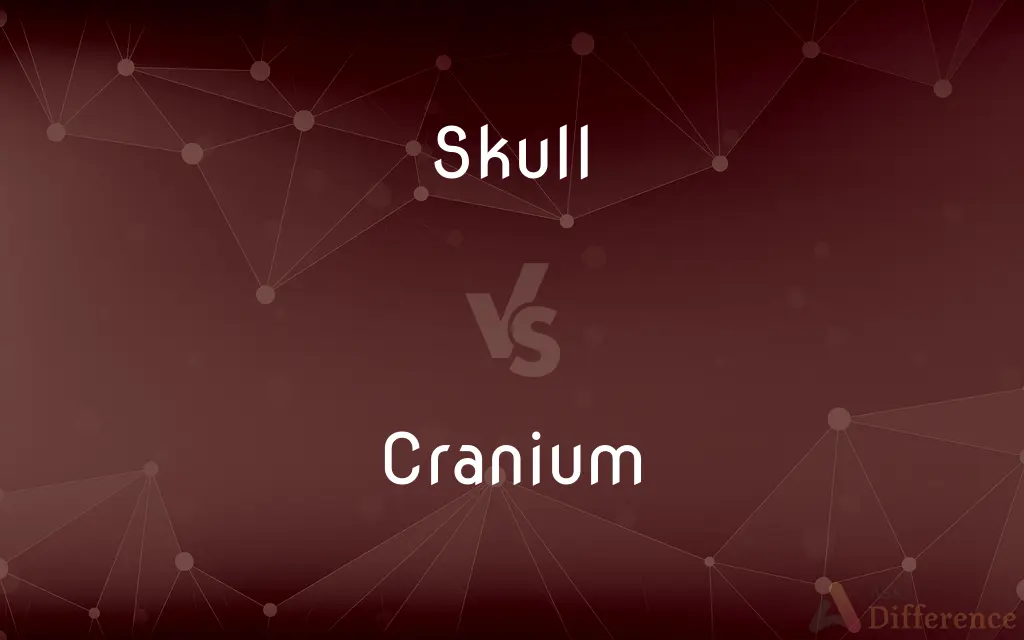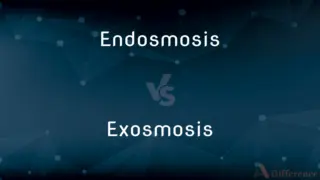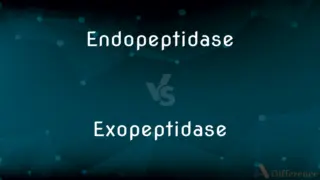Skull vs. Cranium — What's the Difference?
Edited by Tayyaba Rehman — By Fiza Rafique — Updated on September 26, 2023
The "Skull" refers to the entire bony structure of the head, while the "Cranium" specifically denotes the part that encloses the brain.

Difference Between Skull and Cranium
Table of Contents
ADVERTISEMENT
Key Differences
The "Skull" is a term that broadly describes the bony framework of the head. It comprises several bones, including those of the face and those that surround the brain. In everyday language, when people refer to the "Skull," they usually mean the entirety of this bone structure.
On the other hand, the "Cranium" is a more specific term. When discussing the "Cranium," one refers to the part of the "Skull" that houses and protects the brain. This excludes the bones of the face. In medical and anatomical contexts, the distinction between the "Skull" and the "Cranium" is crucial, as each has different bones and structures.
Moreover, the "Skull" includes the mandible (lower jaw), which is not part of the "Cranium." The mandible is essential for functions like speaking and eating. But when one mentions the "Cranium," they're exclusively talking about the upper part of the skull, minus the jaw.
Interestingly, both "Skull" and "Cranium" have taken on symbolic and cultural meanings. The "Skull" often represents mortality, danger, or piracy, as seen in skull and crossbones symbols. Meanwhile, the "Cranium" might be more likely to conjure images related to thought, the mind, or intellect due to its association with the brain.
Comparison Chart
Primary Definition
Entire bony structure of the head
Part of the skull enclosing the brain
ADVERTISEMENT
Components
Includes facial bones and cranium
Excludes facial bones
Includes Mandible?
Yes
No
Symbolic Representations
Often denotes mortality or danger
More linked to thought and intellect
Usage
Broader in everyday language
Specific in medical and anatomical contexts
Compare with Definitions
Skull
A symbol of mortality or danger.
Pirates use a skull and crossbones flag.
Cranium
The upper part of the skull, minus the jaw.
The cranium consists of several bones fused together.
Skull
A representation of the head in art or symbols.
The artist drew a detailed skull.
Cranium
The part of the skull that encloses the brain.
The cranium protects our brain from injuries.
Skull
The remains of the head's bony part.
Archaeologists discovered an ancient skull.
Cranium
The bony vault forming the brain's protective casing.
A thick cranium helped early humans survive impacts.
Skull
The framework housing the brain and facial structures.
The skull provides protection for the brain.
Cranium
The structure supporting the scalp and hair.
Her cranium was smooth and symmetrical.
Skull
The skull is a bone structure that forms the head in vertebrates. It supports the structures of the face and provides a protective cavity for the brain.
Cranium
The skull's section that is above the eyes and ears.
The cranium can be felt as the rounded top of the head.
Skull
A bone framework enclosing the brain of a vertebrate; the skeleton of a person's or animal's head
He broke his collar bone and fractured his skull
Cranium
The skull.
Skull
Hit (someone) on the head
My waking came in drugged stages—I had been skulled
Cranium
The portion of the skull enclosing the brain; the braincase.
Skull
The bony or cartilaginous framework that encloses and protects the brain and sense organs of all vertebrates and of one group of nonvertebrates (the hagfishes); cranium.
Cranium
(skeleton) That part of the skull consisting of the bones enclosing the brain, but not including the bones of the face or jaw.
Skull
(Informal)The head, regarded as the seat of thought or intelligence
Use your skull and solve the problem.
Cranium
The upper portion of the skull, including the neurocranium and facial bones, but not including the jawbone (mandible).
Skull
A death's-head.
Cranium
(informal) skull.
Skull
(anatomy) The main bones of the head considered as a unit; including the cranium, facial bones, and mandible.
Cranium
The skull of an animal; especially, that part of the skull, either cartilaginous or bony, which immediately incloses the brain; the brain case or brainpan. See Skull.
Skull
These bones as a symbol for death; death's-head.
Cranium
The part of the skull that encloses the brain
Skull
(figuratively) The mind or brain.
Skull
A crust formed on the ladle, etc. by the partial cooling of molten metal.
Skull
The crown of the headpiece in armour.
Skull
(Scotland) A shallow bow-handled basket.
Skull
Obsolete form of school
Skull
To hit in the head with a fist, a weapon, or a thrown object.
Skull
To strike the top of (the ball).
Skull
A school, company, or shoal.
A knavish skull of boys and girls did pelt at him.
These fishes enter in great flotes and skulls.
Skull
The skeleton of the head of a vertebrate animal, including the brain case, or cranium, and the bones and cartilages of the face and mouth. See Illusts. of Carnivora, of Facial angles under Facial, and of Skeleton, in Appendix.
Skull
The head or brain; the seat of intelligence; mind.
Skulls that can not teach, and will not learn.
Skull
A covering for the head; a skullcap.
Let me put on my skull first.
Skull
A sort of oar. See Scull.
Skull
The bony skeleton of the head of vertebrates
Skull
The bony structure of the head, including the face.
The museum displayed a human skull.
Common Curiosities
Why is the "Cranium" important?
The "Cranium" protects the brain from injuries.
Is the mandible part of the "Cranium"?
No, the mandible is part of the "Skull" but not the "Cranium."
Can "Skull" refer to symbolism?
Yes, "Skull" often symbolizes mortality or danger.
Is the "Cranium" the same as the "Skull"?
No, the "Cranium" is part of the "Skull" that encloses the brain.
Is the "Cranium" linked to intellect?
Symbolically, the "Cranium" relates to thought and the mind due to its association with the brain.
Is the "Skull" unique to humans?
No, many vertebrates have skulls.
Are the terms "Skull" and "Cranium" used in medical contexts?
Yes, especially "Cranium," which has specific anatomical implications.
Does the "Skull" include facial bones?
Yes, the "Skull" comprises both facial bones and the cranium.
How many bones form the "Cranium"?
The "Cranium" is formed by eight bones.
What's the main function of the "Cranium"?
The primary function of the "Cranium" is to protect the brain.
Can "Skull" be used in cultural or artistic contexts?
Yes, the "Skull" is a popular motif in art and culture.
Is the "Cranium" a solid bone?
No, the "Cranium" consists of several bones fused together.
Which is more specific, "Skull" or "Cranium"?
"Cranium" is more specific, referring only to the brain's enclosure.
What connects the "Cranium" to the spine?
The foramen magnum in the "Skull" connects the "Cranium" to the spinal column.
Do all animals have a "Cranium"?
Many vertebrates have a cranium, but its structure can vary between species.
Share Your Discovery

Previous Comparison
Endosmosis vs. Exosmosis
Next Comparison
Endopeptidase vs. ExopeptidaseAuthor Spotlight
Written by
Fiza RafiqueFiza Rafique is a skilled content writer at AskDifference.com, where she meticulously refines and enhances written pieces. Drawing from her vast editorial expertise, Fiza ensures clarity, accuracy, and precision in every article. Passionate about language, she continually seeks to elevate the quality of content for readers worldwide.
Edited by
Tayyaba RehmanTayyaba Rehman is a distinguished writer, currently serving as a primary contributor to askdifference.com. As a researcher in semantics and etymology, Tayyaba's passion for the complexity of languages and their distinctions has found a perfect home on the platform. Tayyaba delves into the intricacies of language, distinguishing between commonly confused words and phrases, thereby providing clarity for readers worldwide.
















































